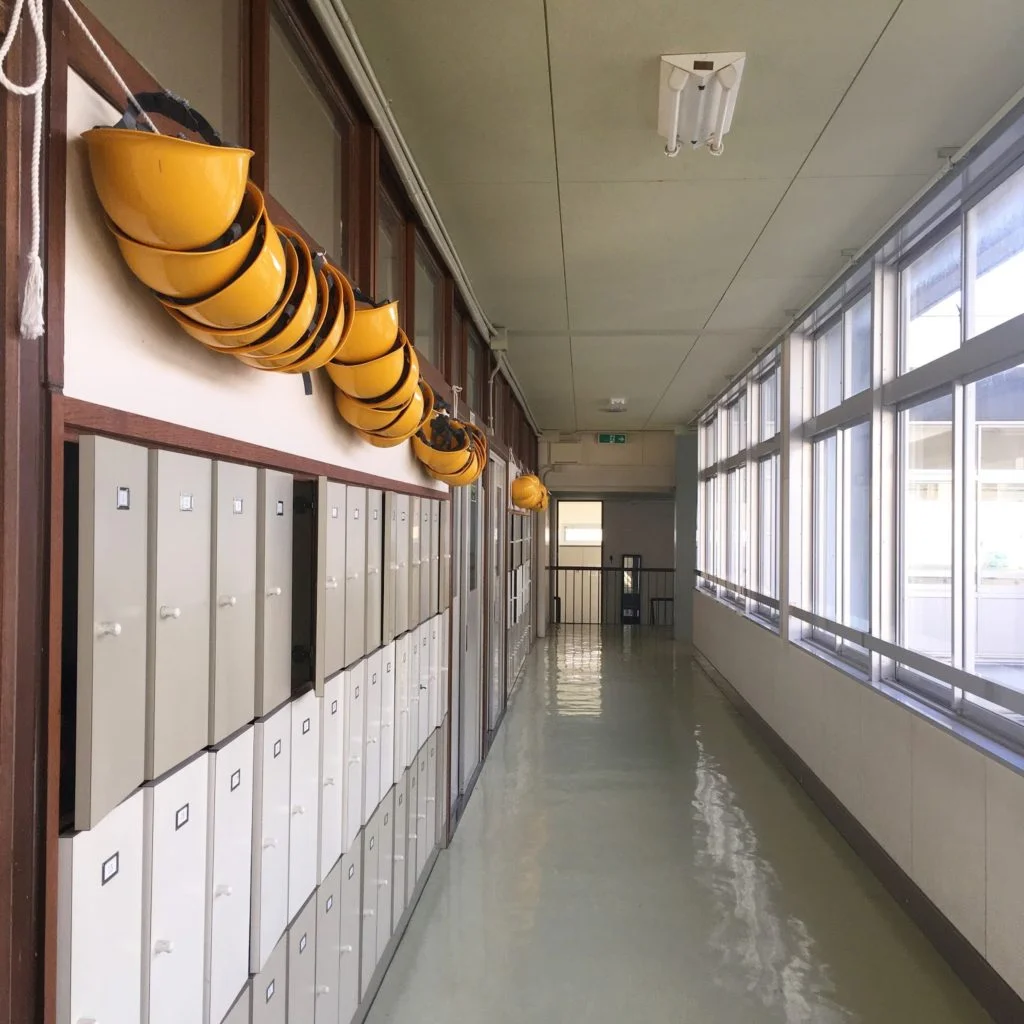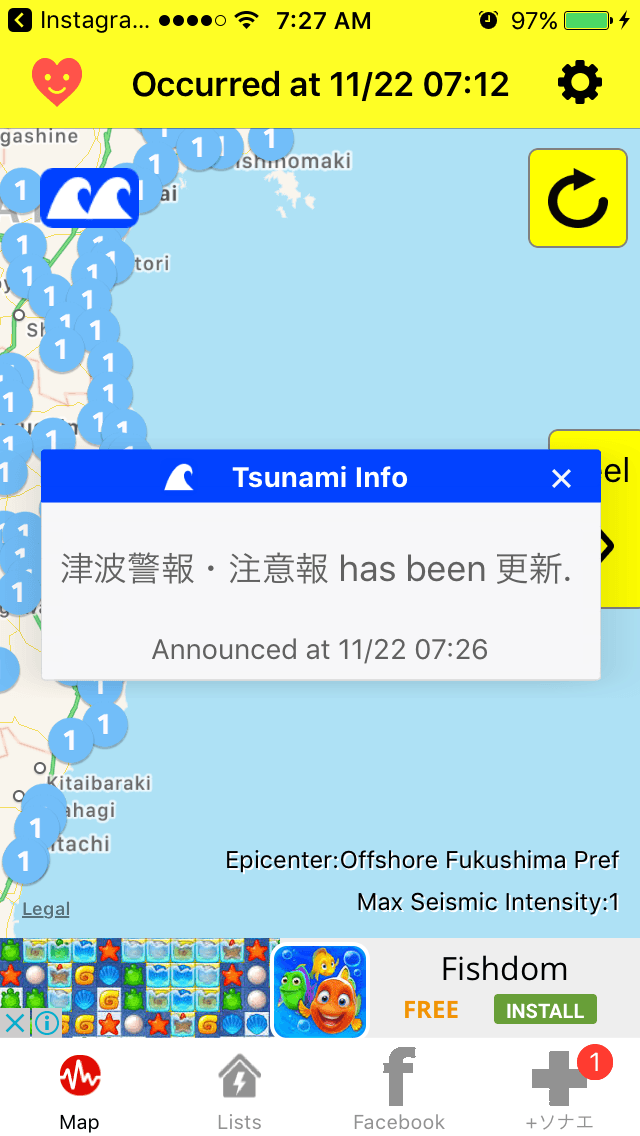One thing I kind of forgot about when I got all excited about moving to Japan was earthquakes.
Japan has A LOT of earthquakes. Actually, 6% of all the earthquakes in the whole damn world happen here. We get about 1500 a year.
Our disaster preparation seminar at orientation was comprised of 30 minutes of showing footage from the 2011 earthquake and tsunami disaster, a short remembrance of a JET Programme participant who died in the disaster, and a card to put in our wallets with emergency info in English and Japanese that we were supposed to fill out. Then they basically told us that the disaster communication from the program failed in 2011 and again in the 2016 Kumamoto quake, and that we would have to rely on ourselves and our local community if a disaster occurred. Uh, okay, great? Thanks?
Our prefectural orientation was a whole different story. They regaled us with information about the predicted Nankai Earthquake and Tsunami. TL;DR article – the area where I live has a good chance of having a massive earthquake and a 30m/100ft tall tsunami in the next 20-50 years. They are expecting about 200,000-400,000 people to die and uncountable damages.
By the way, I live right by the ocean. My apartment is riverfront. I work at schools on an island below sea level. If this Nankai Earthquake happens while I’m here, I’m pretty much guaranteed to be toast.
The government’s figures put the odds of a magnitude 8.0-plus Nankai Trough earthquake at 50% in the next 20 years, 70% in the next 30 years and 90% in the next 50 years. – Financial Times
I had been in a couple smaller earthquakes when I lived in Roatan, and it was nothing to write home about. Once I was on the toilet, of all places, and got one small jolt to the side and that was it. I wasn’t sure if it was my hangover or what. I only found out the next day that it was an earthquake.
In Japan, earthquakes are another story. I’ve only been here four months now, and I’ve been in two big enough to scare me, and countless smaller ones.
The first happened while I was in class. I heard a sound like a typhoon-level wind and looked outside but the trees were still. This cognitive dissonance sent my brain into a tailspin, and while I was trying to figure out what was happening, the shaking started. Here’s something you might not know about Japan: most schools and homes have sliding doors and sliding windows. All of a sudden students dove under desks, the doors and windows started smashing around, and pens went rolling off desks. I was standing there trying to steady myself against a wall, not sure what to do. No one had told me what to do if there was an earthquake at school. Then the evacuation siren started wailing, and suddenly everyone was yelling in Japanese. Teachers shouted instructions I couldn’t understand, students ran to the ripcords to let down the earthquake helmets and buckled in as they ran outside to the baseball field. Someone shoved a white teacher helmet into my hands and I followed my students outside while the building was still rumbling. Students lined up in the field in their homeroom classes as I stood around trembling and getting teary-eyed from fear, because I didn’t know what was happening, my phone was inside, and I couldn’t find my teachers who spoke English to explain to me what was going on or how serious things were.
 |
| flippantly took this pic for instagram a week before my students were in these helmets |
I finally found my English teachers and they told me it was safe to go back inside, the quake was from far away and we had no danger of tsunami. I went to the staff room where they had the national news channel on, and we found out this was the 2016 Tottori Earthquake which was a M6.6/Upper 6 quake about 220km away from where I live. In my city, it was a Lower 5 and we were lucky to have very little damage compared to Tottori. (Note: Japan uses a different earthquake classification system than the rest of the world, because Japan would never deign to use the trash created by Western scientists, obviously. It’s here for reference.)
As we were sitting in the staff room, aftershocks rolled in which were smaller but freaked the teachers out a bit. Once we got the all-clear from the news, we went back to class. The students were super chill about the whole thing and were happy about a break from class. Kids around the world are still kids, ha!
About a month later, I was sitting at home on the weekend and I heard the same typhoon-wind sound and looked outside to calm trees. I immediately panicked and realized an earthquake was coming as my house started to shake and dishes rattled. I stood in a doorway and lamented that I would have to grab my emergency backpack and run for the hills in my PJs, which featured a see-through top with no bra on, and ill-fitting sweatpants. It was smaller than the previous one (turned out it was only a 4 and located about 140km from me) and as the shaking subsided I immediately got on my phone with the other ALTs who live in my building. About half of them had received an earthquake warning on their phone, and half (including me) did not. In Japan, all phones are supposed to display earthquake and tsunami warnings (text alerts which make a specific, loud, unchangeable noise that goes off whether you have your phone on silent or not), sent out to local areas by government. So some of them knew the expected intensity and duration almost 20 seconds before the shaking started. Personally, I don’t like being surprised by earthquakes. I’m not into living that much on the edge.
A few days later, I finally got a warning. It showed up on my phone like this:
So yeah, can you read this? If you can, congrats. Your life in Japan would be/is much easier than mine. But I CAN’T READ THIS. The only parts I can read say “Kitajima-machi” (Kitajima Town, the neighborhood next to mine) and “tsunami”. So of course, I freaked out that a tsunami was coming, because that’s all I could read!
As it turns out, the first kanji in the brackets means “training”. Kitajima was having a tsunami drill. Faaaaaaaaaccccccccccckkkkkkkkkkkkk. Gave me a damn heart attack.
A few days later (after I downloaded an English early warning app), I woke up at 6am to my phone blowing up with Facebook messages and snaps. “Are you okay?” “Are you okay?” “Are you okay?”
“Holy shit”, I thought, “my stupid warning thing didn’t work again!”
I frantically checked my phone and found out that a) it’s still not really in English (see photo below) and b) thank god for pictures, because there was an earthquake and a tsunami, but it was up in Fukushima which is way far north of me and I was not in any danger.
 |
| thank you for this excellent english app, very helpful |
At school today, it’s a windy day. I was in class and the doors started shaking around from the wind. In the split second before I remembered the wind, my brain went straight to earthquake. While I don’t love this sort of PTSD I’ve developed, it may save my life one day. It’s funny how from only a few experiences, the way I look at things in Japan has changed. I am always checking above me at school to see what could fall on me. I’ve rearranged my house so that anything that might fall over won’t block an exit. I moved my emergency backpack to an easier-to-grab location and got a few more items for it. I bolted some furniture to the walls, and next paycheck I’ll be buying a closed kitchen cabinet island rather than the open shelving I have now (which will be fucking disaster if it starts shaking hard enough). I moved heavy appliances and breakable items from high cupboards to low ones. I leave a pair of slip-on shoes and a jacket by the door, and wrote up an emergency exit post-it note that I can quickly leave on my door with my info if I evacuate. If the big one comes, I’m screwed either way….but in the meantime, I’m doing everything I can to make sure I come out okay.
Life in Japan is full of weird and wonderful things. One of the things is earthquakes. As humans, we have to learn lessons from previous tragedies and do what we can to prevent them happening again. As for me, if things start going sideways you can look for me at the top of the mountain in my backyard… because if things start shaking, this girl is going UP.
Guys, make sure to follow me on Facebook, Instagram and Twitter … there’s lots of extras posted there that don’t make it onto the blog. I also have Google+ if anyone even uses that? And I’m on Bloglovin’, so you can follow me there too! Plus it makes me try to post more than once a month. So there’s that.

This is a fascinating post. I experienced only one earthquake while I was in Tokyo for five weeks last year, and it was strong enough to shut down some of the trains for a few hours. I was inside a 7-11 when it happened, and I remember being mesmerized by the shaking of the drink bottles in the cooler next to me as it happened.
Thanks Steven, I’m glad you enjoyed it! I know what you mean about the drink bottles – the same thing happened to me while I was watching my dishes rattle around (and hoping it wouldn’t get any bigger or they’d all smash!)
I used to use an app called Yure Kuru Call which was also in English if I remember rightly. It would say if there was an earthquake coming, and was very accurate.
Thanks doll! The one I have in the pic with the yellow, and the kanji mixed with English actually is Yure Kuru Call!! Some of the alerts from it have been in English, but all the tsunami info was English mixed with kanji 🙁